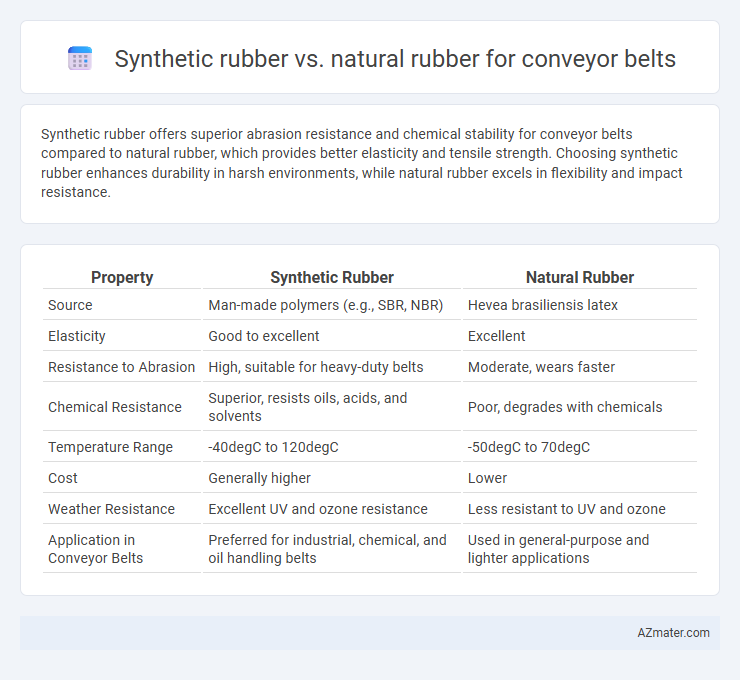Synthetic rubber offers superior abrasion resistance and chemical stability for conveyor belts compared to natural rubber, which provides better elasticity and tensile strength. Choosing synthetic rubber enhances durability in harsh environments, while natural rubber excels in flexibility and impact resistance.
Table of Comparison
| Property | Synthetic Rubber | Natural Rubber |
|---|---|---|
| Source | Man-made polymers (e.g., SBR, NBR) | Hevea brasiliensis latex |
| Elasticity | Good to excellent | Excellent |
| Resistance to Abrasion | High, suitable for heavy-duty belts | Moderate, wears faster |
| Chemical Resistance | Superior, resists oils, acids, and solvents | Poor, degrades with chemicals |
| Temperature Range | -40degC to 120degC | -50degC to 70degC |
| Cost | Generally higher | Lower |
| Weather Resistance | Excellent UV and ozone resistance | Less resistant to UV and ozone |
| Application in Conveyor Belts | Preferred for industrial, chemical, and oil handling belts | Used in general-purpose and lighter applications |
Introduction to Conveyor Belt Materials
Synthetic rubber, such as nitrile, neoprene, and styrene-butadiene, offers enhanced resistance to abrasion, heat, oils, and chemicals, making it ideal for conveyor belts in industrial and harsh environments. Natural rubber provides excellent tensile strength, elasticity, and impact resistance but is less effective against oil and chemical exposure. Conveyor belt materials selection depends on specific application requirements, balancing durability, flexibility, and environmental conditions.
Overview of Synthetic Rubber
Synthetic rubber, primarily composed of polymers such as styrene-butadiene rubber (SBR) and nitrile rubber (NBR), is engineered for enhanced durability, chemical resistance, and temperature tolerance in conveyor belt applications. Unlike natural rubber, synthetic variants provide superior abrasion resistance and consistent performance in harsh industrial environments, making them ideal for heavy-duty material handling. The ability to customize synthetic rubber formulations ensures optimal mechanical properties and improved longevity for conveyor belts used across mining, manufacturing, and logistics sectors.
Overview of Natural Rubber
Natural rubber is derived from the latex of the Hevea brasiliensis tree, offering excellent elasticity, tensile strength, and resistance to abrasion, making it highly suitable for conveyor belt applications in industries such as mining and agriculture. Its natural polymers provide superior grip and flexibility, which enhances belt performance under heavy loads and varying temperatures. Despite its vulnerability to oil and chemical exposure, natural rubber remains preferred for environments requiring resilience and impact resistance.
Key Performance Differences
Synthetic rubber offers superior abrasion resistance and temperature tolerance compared to natural rubber, making it ideal for conveyor belts operating in harsh industrial environments. Natural rubber provides excellent elasticity and tensile strength but is more susceptible to degradation from oils, chemicals, and UV exposure. Key performance differences include synthetic rubber's enhanced durability and resistance to environmental factors, while natural rubber is favored for flexibility and shock absorption in less demanding applications.
Durability and Wear Resistance
Synthetic rubber used in conveyor belts offers superior durability and wear resistance compared to natural rubber, due to its enhanced chemical composition and uniform molecular structure. It resists abrasion, heat, and chemicals more effectively, prolonging belt life under harsh industrial conditions. Natural rubber provides excellent elasticity but tends to degrade faster when exposed to oils, ozone, and extreme temperatures, limiting its wear resistance for heavy-duty conveyor applications.
Flexibility and Handling
Synthetic rubber offers superior flexibility and enhanced handling characteristics for conveyor belts, especially in extreme temperature or chemical exposure conditions. Natural rubber provides excellent elasticity and high tensile strength, making it ideal for applications requiring resilience and shock absorption. However, synthetic variants often outperform natural rubber in durability and resistance to wear, ensuring longer service life and consistent performance.
Cost Comparison and Economic Impact
Synthetic rubber conveyor belts generally exhibit higher initial costs compared to natural rubber due to complex manufacturing processes and specialized raw materials. Despite the upfront expense, synthetic options often deliver longer service life and enhanced durability, reducing replacement frequency and downtime costs. Natural rubber provides a more affordable initial investment, but its susceptibility to wear and environmental degradation may result in increased maintenance and overall lifecycle expenses for conveyor belt applications.
Environmental Considerations
Synthetic rubber conveyor belts often have a higher environmental impact due to their petroleum-based origins and energy-intensive manufacturing processes, contributing to greater carbon footprints and waste generation. Natural rubber, sourced from rubber trees, offers a renewable and biodegradable alternative, promoting sustainable forestry practices and reducing reliance on fossil fuels. However, natural rubber production can lead to deforestation and habitat loss if not managed responsibly, highlighting the need for certified sustainable sourcing in conveyor belt applications.
Applications in Various Industries
Synthetic rubber, such as nitrile and neoprene, is widely used in conveyor belts for industries requiring resistance to oil, chemicals, and extreme temperatures, including automotive manufacturing, mining, and food processing. Natural rubber conveyor belts excel in applications demanding high tensile strength, flexibility, and abrasion resistance, making them ideal for agriculture, forestry, and quarrying operations. The choice between synthetic and natural rubber depends on specific industrial requirements like exposure to harsh environments, load capacity, and durability.
Choosing the Right Rubber for Conveyor Belts
Selecting the right rubber for conveyor belts hinges on the specific application requirements such as durability, resistance to abrasion, and environmental conditions. Synthetic rubber, including types like SBR and EPDM, offers superior resistance to heat, chemicals, and wear, making it ideal for harsh industrial settings. Natural rubber provides excellent flexibility and tensile strength, preferred for applications requiring high impact resistance and low-temperature performance.

Infographic: Synthetic rubber vs Natural rubber for Conveyor belt
 azmater.com
azmater.com